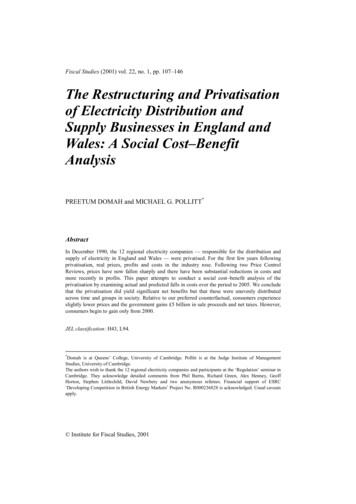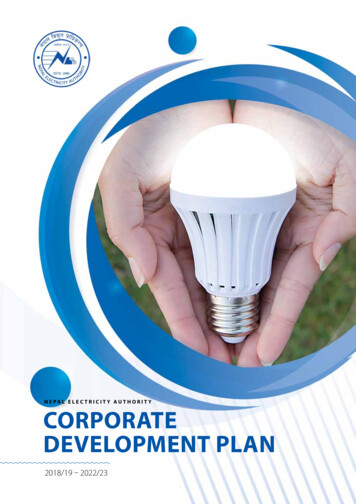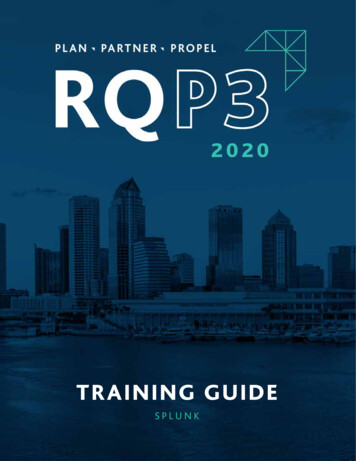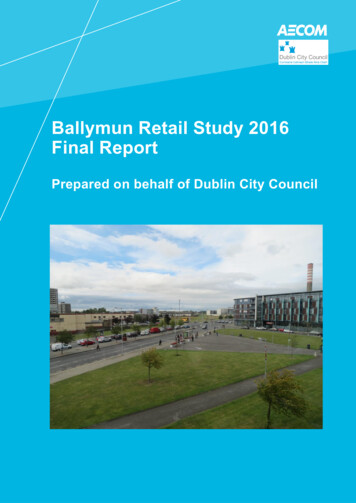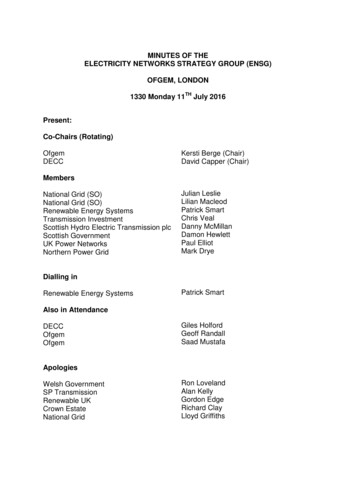
Transcription
MINUTES OF THEELECTRICITY NETWORKS STRATEGY GROUP (ENSG)OFGEM, LONDON1330 Monday 11TH July 2016Present:Co-Chairs (Rotating)OfgemDECCKersti Berge (Chair)David Capper (Chair)MembersNational Grid (SO)National Grid (SO)Renewable Energy SystemsTransmission InvestmentScottish Hydro Electric Transmission plcScottish GovernmentUK Power NetworksNorthern Power GridJulian LeslieLilian MacleodPatrick SmartChris VealDanny McMillanDamon HewlettPaul ElliotMark DryeDialling inRenewable Energy SystemsPatrick SmartAlso in AttendanceDECCOfgemOfgemGiles HolfordGeoff RandallSaad MustafaApologiesWelsh GovernmentSP TransmissionRenewable UKCrown EstateNational GridRon LovelandAlan KellyGordon EdgeRichard ClayLloyd Griffiths
Welcome and Introduction including minutes and actions from last meeting1. The Chair welcomed participants to the meeting. The meeting notes from the 7December 2015 ENSG meeting had been agreed, circulated and published onthe ENSG webpages. The Chair noted that all the actions from the Decembermeeting had been completed.System Operator Update on the Future Energy Scenarios2. The System Operator (SO) provided an overview of its 2016 Future EnergyScenarios (FES)1, which had been published at the end of November.The scenarios were based on the energy trilemma of security of supply,affordability and sustainability. They provided stakeholders with a range of‘plausible and credible’ pathways for the future of energy out to 2050. It coveredelectricity and gas, as well as supply and demand.3. The SO noted that the major takeaways from this year’s FES were: The decarbonisation agenda was driving significant changes to the energysupply market. Traditional sources of supply were being replaced with anever-divergent mix (estimated 5GW decline in fossil fuel generation in 2016,while renewable capacities increased. At the same time their scenariosshowed a maximum of 18GW of electricity storage by 2040). Over the past year the volume of renewable electricity sources had increasedsubstantially. While the electricity generation sector was on the requiredtrajectory, significant progress was still needed in the heating and transportsectors if the UK was to meet the 2020 renewable target on time (to reach thetarget, a 170% increase in renewable heat would be required – an increase ofaround 60 TWh). Action needed to be taken this decade to drive progress towards the 2050carbon reduction target - three key technologies which will enable electricitydecarbonisation were: nuclear, renewables and carbon capture and storage(CCS). The cost-optimal pathway utilises all three of these technologies;approximately 22 GW of nuclear, 100 GW of renewables and 20 GW of CCSin 2050. The importance of gas in GB’s energy mix was further emphasised this year.It would continue to play a key role in energy decarbonisation, by providingflexible electricity generation and top-up heating over the long term. Gaswould support the electrification of heating by providing top-up heating at peaktimes. In 2030 in the Gone Green scenario, 70% per cent of homes would stilluse gas for all, or part, of their heating requirements.Discussion4. A question was raised as to how the four scenarios in the FES related to theENTSO-E Ten Year Network Development Plan (TYNDP) scenarios. The SOhighlighted that there was no direct correlation between the two due to thedifferent inputs and requirements. However, the SO also noted that the ENTSO-E1National Grid’s 2016 FES http://fes.nationalgrid.com/
report also had four scenarios (Visions 1-4) and there may be some similaritieswith the SO’s Gone Green and No Progression scenarios, albeit with somedegree of flex.5. A member queried how the new Pan-European Model would impact futurepublications of the FES. The SO noted that the new model would allow them toforecast what capacity was needed and when, for the net benefit of the GBconsumer.6. The Chair asked the SO to provide a high level overview of storage in the FES.National Grid pointed out that Consumer Power and Gone Green were the twoscenarios most favourable to storage. They forecast 1GW of storage on thenetwork by 2020, and noted that there was 30MW of battery storage currently onthe network; however this was mostly for trial purposes. The SO also noted thatthe FES highlighted some commercial and regulatory barriers that would need tobe overcome for storage to become prevalent on the network.7. UKPN noted that DNOs were trying to see themselves as more active networkmanagers and the insights provided by the FES were very useful in that regard.8. The Chair questioned whether storage assumptions were reliant onimprovements in the commercial and regulatory frameworks; and whatcontributed to storage numbers being significantly higher than in last year’s FES.The SO noted that better market conditions, clarity on commercial and regulatoryframeworks, and how batteries are defined would all contribute to its increaseduptake. It was also noted that storage was needed to allow the levels ofembedded generation that were currently on the network. The SO noted that itsaw at the System Operability Framework, the Power Responsive document, andthe FES as one, to see interactions and get a holistic view of the network.9. Ofgem questioned whether batteries could provide a frequency response service.The SO explained that they could. In fact it noted that storage can have a numberof potential applications such as balancing and ancillary services, asset servicesand wholesale and arbitrage services. A full list was available in the FESdocument.10. A member questioned whether the FES would be revisited once the impact of theunfolding political changes becomes clearer. The SO noted that the FESprovided an envelope of options and any change should still fall within thatenvelope.11. A member questioned what actions needed to be taken this decade to meet the2050 targets. The SO highlighted the continued decarbonisation of electricitygeneration, decarbonisation of heat (with a policy framework for consumers toswitch from gas boilers), and electric vehicles as a mass form of transport as thekey areas. This would require a least two of renewables, Carbon Capture andStorage (CCS) and nuclear technologies.
3. SO Update on the Network Options Assessment (NOA)12. The SO provided an update on its NOA, which described the options that theTransmission Owners had provided to meet reinforcement requirements ofboundaries on the national electricity transmission system. The report went on toidentify the SO’s preferred option or options based on Cost Benefit Analysis foreach boundary.13. For the 2015/16 NOA, The SO had considered more than seventy GBtransmission system investment options. Of those proposed options, thirteenprojects that required a decision this year were identified.14. Their draft NOA 2 methodology was now at an advanced stage. Theirconsultation had now closed and the methodology was to be submitted to Ofgemby August 2016.15. The SO would also provide a view as to whether development options metcompetition criteria i.e. new, separable, and high value.16. The SO was working closely with TOs to agree /gather sufficient data on optioncosts for economic analysis and cost scrutiny. Consideration was being given tocontracting out the detailed scrutiny of TO costs to a third party with relevantasset, project management and construction cost expertise.4. SO update on congested grids17. The SO updated members on the effect distributed generation was having on thetransmission system in terms of high voltages, export limits, forecast errors,reduction in inertia, and contracts for services beyond the distribution andtransmission boundaries.18. In April 2015 the SO had indicated it was not in a position to offer connections toembedded generators. However, following a number of commercial andoperational actions undertaken, it had been able to make over 9GW ofconnection offers.19. On the commercial side, connections above 1MW now needed to go through theStatement of Works process; there were restrictions being applied to certainconnections, and there was greater data sharing with between the SO and theDNOs.20. On the operational side, there were now lower target voltages on the DNOnetwork, switch out transmission circuits on the network for voltage control, andan ensured capacitive compensation plant on the DNO network is switched out.21. A number of issues still existed however and would require further actions. TheSO highlighted South Wales as an example of an area that was still constrained(for new thermal generation).
Discussion22. A number of members indicated that although there had been improvementssome of the measures undertaken by the SO were short-term. There was a needfor a review of grid connection arrangements and a longer term strategy orroadmap.23. One member indicated that constrained connections at the distribution level werenot a no-cost option, as they incurred costs for the generator. This should befactored into future decisions.24. The SO stressed that solutions were available but there were questionssurrounding the timing of these remedies and their commercial viability.5. Issues arising from the EU referendum result25. DECC provided an update on issues that the government would dealing with inrelation to the networks over the coming months and years as a result of therecent EU referendum result.26. It was explained that that the UK was currently still a part of the EU and thatexisting legislation (including regulations and directives) remained in place for thetime being.27. Government policy on Interconnectors had not changed as the case for thesecontinued to be based on solid market fundamentals. DECC further highlightedthat the UK was still obligated by the current EU network codes, and current workon these would continue.28. Going forward DECC would be considering the implications of the referendum onall aspects of the networks. Members were asked if they could consider this tooand let DECC know of any particular issues or concerns that they identified.Discussion29. Transmission Investment indicated that it was pressing ahead with their projectfor a new Interconnector with France.30. One member queried the extent to which the UK would still be a part of theinternal European Energy Market, or whether there would be a more bilateraltype arrangement with tariffs. DECC explained that this is one of the areas thatwould become clearer in due course, when any negotiations got underway.31. The Chair highlighted that whilst Ofgem was an independent regulator andtherefore not at the frontline of negotiations, it would also welcome comments orquestions on this issue from stakeholders through the ENSG Secretariat.Action 1 ENSG members to consider issues arising from the EU referendumthat might need government to consider and let DECC and Ofgem know.
5. TO updates32. National Grid and Scottish Hydro Electric Transmission (SHE Transmission)provided an update on their major projects.33. SHE Transmission highlighted the Beauly-Denny line which had been energisedat the end of last year and would be fully completed by September and theCaithness-Moray project which was under construction -this was on track fordelivery in 2018.34. SHE Transmission was also developing the needs cases for the proposedWestern Isles and Shetland links, which it planned to submit to Ofgem whenneeded (these were dependent on the forthcoming CfD allocation). The proposedOrkney link was also under consideration, talking account of changes ingeneration deployment.35. National Grid highlighted their Mid-Wales project, which remained suspendedfollowing uncertainties around generation levels and the North Wales projectwhere the connection date was being put back due to revised generationtimescales.36. National Grid also mentioned that a decision had recently been made on SPTransmission’s Dumfries & Galloway Strategic Reinforcement project, which wasnow planned to be a smaller project than originally envisaged.6. Mid Period Review (MPR) update37. Ofgem gave a short update on its Mid Period Review of RIIO-T1 and GD1.38. Ofgem had decided to launch an MPR for the RIIO-T1 price control looking atsome specific issues in Electricity Transmission for National Grid ElectricityTransmission and Gas Transmission for National Grid Gas Transmission.39. No issues had been identified as being within scope of an MPR in RIIO-T1 foreither of the Scottish Transmission Owners. Ofgem had further decided not tolaunch an MPR for the RIIO-GD1 price control.7. AOB and next meeting40. Members discussed the purpose of the ENSG and whether it remained a usefulforum.41. Transmission Investment said that whilst it was a big meeting, they thought thatthe new twice-yearly format worked well. They further pointed out that while someof the issues it looked at were considered in other forums, it was able to coverother issues that were not being captured, thus had an added value. They added
that given how quickly the networks were now evolving it was likely that otherissues could easily arise, that could be picked up by the ENSG.42. The SO mentioned that the ENSG had been more strategic in the past andideally should look at where the electricity system should be in 3-5 years’ timeand the steps needed to get there.43. RES pointed out that the rationale for the ENSG had changed as today’schallenges were different than those posed when the group was first formed. Forinstance there was currently a good deal of discussion on DNO/TO/SOinteraction, and a group such as this was useful to help prevent stakeholdersfrom working in silos.44. UKPN highlighted that technological advances would mean the network willchange going forward and it was therefore good to be able to discuss theseissues in this forum.45. The Chair indicated her preference for the ENSG to look more at whole systemissues as other forums covered more specific aspects of the networks.46. DECC pointed out that a lot of the new behaviours that the ENSG has promotedhad since become embedded into our way of working.47. The Chair thanked members for their time and effort. She indicated that theSecretariat would shortly send round the minutes of this meeting and aprovisional date for the next meeting.Action 2:ENSG Secretariat to circulate minutes of this meeting and send out the datefor the next meeting (likely in December).
ENTSO-E Ten Year Network Development Plan (TYNDP) scenarios. The SO . the FES as one, to see interactions and get a holistic view of the network. 9. Ofgem questioned whether batteries could provide a frequency response service. . an ensured capacitive compensation plant on the DNO network is switched out. 21. A number of issues still .






